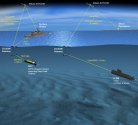Poseidon is a very notional capability to deliver a nuclear warhead against a coastal installation, bypassing American BMD.
I am not convinced China is thinking along such lines. As someone else on Twitter pointed out, the designation of the carrier vehicle indicates an uncrewed system, ie a drone, and perhaps as such not a weapon. Although the distinction is not always clear, nowadays.
Wasn't there a concept of a super long ranged torpedo floating around?
Except that was meant to use a novel, low cost nuclear propulsion system so you could justify using conventional warheads on them.
Not sure how vulnerable regular container ships are to a single suicide UUV this size however.

